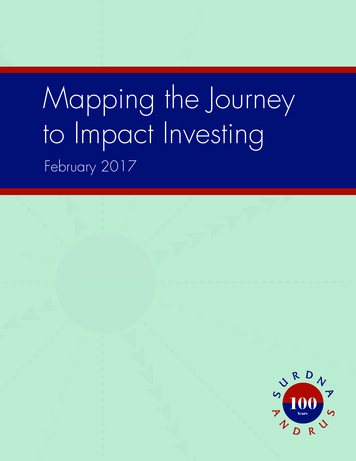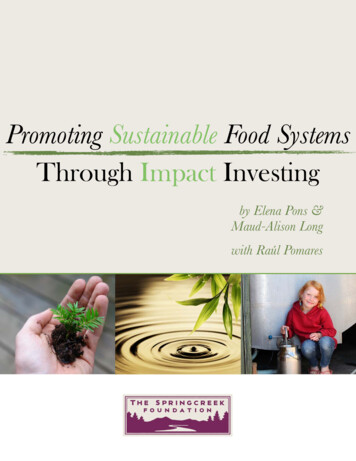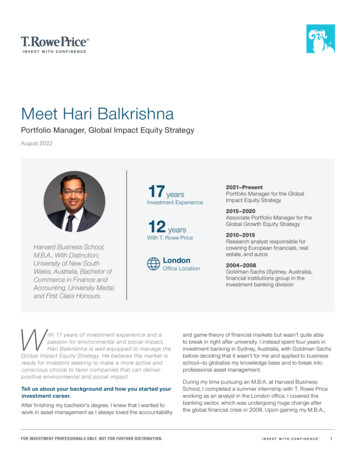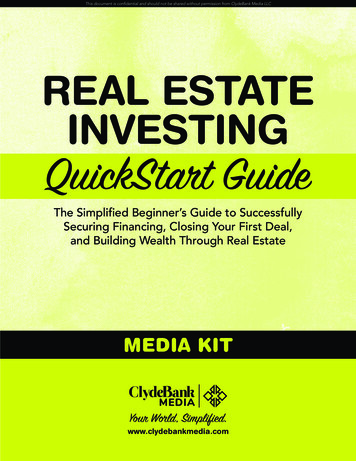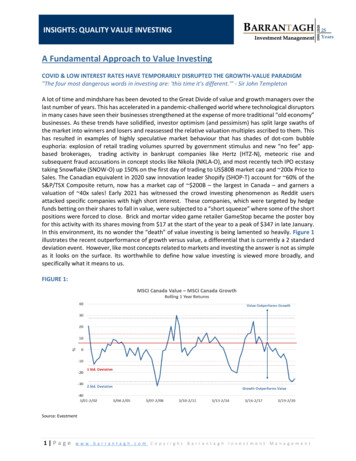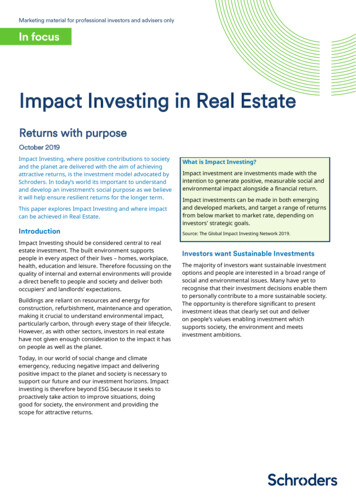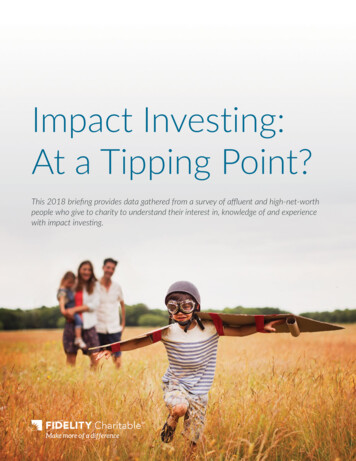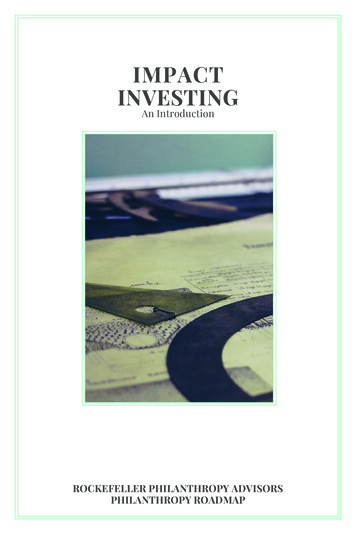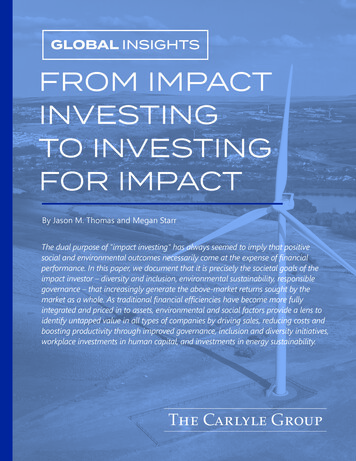
Transcription
GLOBAL INSIGHTSFROM IMPACTINVESTINGTO INVESTINGFOR IMPACTBy Jason M. Thomas and Megan StarrThe dual purpose of "impact investing" has always seemed to imply that positivesocial and environmental outcomes necessarily come at the expense of financialperformance. In this paper, we document that it is precisely the societal goals of theimpact investor – diversity and inclusion, environmental sustainability, responsiblegovernance – that increasingly generate the above-market returns sought by themarket as a whole. As traditional financial efficiencies have become more fullyintegrated and priced in to assets, environmental and social factors provide a lens toidentify untapped value in all types of companies by driving sales, reducing costs andboosting productivity through improved governance, inclusion and diversity initiatives,workplace investments in human capital, and investments in energy sustainability.1
FROM IMPACT INVESTING TO INVESTING FOR IMPACTThe phrase “impact investing” was coined in 2007 to describea new form of financial intermediation that combines socialand environmental mission-orientation with traditional assetmanagement.1 From the outset, the dual purpose of thestrategy seemed to suggest that positive social and environmental outcomes necessarily come at the expense of financial performance. Researchers focused on impact’s “cost” interms of foregone returns,2 often implying that traditionalstrategies must involve some degree of social or environmental degradation. As initially conceived, impact investingseemed predicated on a “damned if you do, damned if youdon’t” mindset that treats genuine impact as irreconcilablewith (risk-adjusted) return maximization.By Jason M. Thomasand Megan Starractually impede improvements in investment performance.By presuming that social benefits detract from returns,traditional investors ignore the ways an impact orientationcan add (market) value. And by assuming that genuineimpact requires some degree of financial sacrifice,4 impactinvestors can fail to appreciate how socially-optimal strategies manifest themselves in company income statementsand valuations.Improved Governance & Longer-Term OrientationRelative to listed equities, private markets are illiquid,involve more concentrated ownership stakes, and offerinvestors a much greater degree of control over the underlying portfolio companies. These features naturally cultivatea longer-term orientation and a much broader assessmentof risks and opportunities. Investors exchange liquidity forinfluence, a trade-off that could only make sense if thereturns to more active governance compensate for thecosts of being “locked in” to the investment. Since thesereturns typically take years to manifest themselves, privateholding periods tend to be much longer than those of thetypical stock market investor,5 and require a willingness tohold the asset for five or more years.N.B. impact investing traditionally refers to privateinvestments made into companies or assets withthe intention to generate social and environmentalimpact alongside a financial return. ESG integrationstrategies are applicable across both public and privatemarkets, and typically refer to the incorporation ofenvironmental, social, and governance factors into atraditional investment analysis across a wide range ofcompanies. Most institutional investors focus on whereESG factors add material value through differentiatedinsights (however other types of investors use thesetools to express market views or personal priorities).As interest rates have declined and entry multiples haverisen, it is no longer possible to generate historic rates ofreturn without investing for impact – to use the term in avery broad sense. With no tailwinds from falling financecosts, recovering economies, or rising valuations, privatemarkets investors can only meet return targets by consistently building better businesses. And while better businesses tend to be stronger financial performers, companyfinancials provide much too narrow a vantage point toassess the strength or sustainability of a business. A muchbroader lens is required, which examines every componentof the business through a total improvement orientationthat adopts aspects of the intent, actions, and theory ofchange once thought to be the exclusive province of“impact” funds.6As markets have evolved, this stark dichotomization betweensocial and financial returns has become progressively harderto defend.3 The same companies often receive financingfrom both traditional asset managers and dedicated impactfunds. The same pools of capital often commingle fundsfrom highly-motivated environmental, social and governance (ESG) investors with those of investors focused solelyon earning the highest possible (risk-adjusted) return.More consequentially, as we describe in greater detailbelow, it is precisely the societal goals of the impactinvestor – diversity and inclusion, environmental sustainability, responsible governance – that increasingly generatethe above-market returns sought by the market as a whole.As traditional financial efficiencies have become more fullyintegrated and priced in to assets, environmental and socialfactors provide a lens to identify untapped value in all typesof companies by providing means to drive sales, reduce costs,enhance productivity, or expand valuation multiples.Impact investors seek to produce beneficial social outcomesthat would not occur but for their investment in an enterprise.7 While “impact” funds in their purest definition arelimited to investing in companies whose sole, or “core,”business directly addresses a defined set of environmental orsocial challenges, a total improvement orientation assessesthe potential actions to improve social and environmentaloutcomes at all prospective businesses. Hence whileThe assumed trade-off between social benefits and financial returns may not just be outmoded; such thinking could4 Brest P. and K. Born (2013), “When Can Impact Investing Create Real Impact,” Stanford Social Innovation Review.5 Morningstar estimates that the average turnover ratio for managed domestic stock funds is 63%, as ofFeb. 28, 2019.6 Jackson, E. (2013), “Interrogating the Theory of Change: Evaluating Impact Investing Where it MattersMost,” Journal of Sustainable Finance & Investment.7 Brest and Born (2013).1 Höchstädter, A. and B. Scheck. (2015), “What’s in a Name: An Analysis of Impact Investing Understandingsby Academics and Practitioners,” Journal of Business Ethics.2 Barber, B. et al. (2019), “Impact Investing,” NBER Working Paper No. 26582.3 Chowdhry, B. et al. (2019), “Investing for Impact,” Review of Financial Studies.2
impact investing channels capital to a narrowly definedsubset of potential investment opportunities, privatemarkets’ particular characteristics – concentration, control,and a longer time horizon – provide both the opportunitiesand financial incentives for investors to generate beneficialoutcomes across a much broader universe of businesses.of the 1.7 trillion increase in private markets assets undermanagement (AUM) as delistings have waned in significance(Figure 1). With virtually no fat to cut, returns on these investments depend on investors’ ability to catalyze growth, whichtypically results in substantial increases in employment.12FIGURE 1From Cost Containment to Top-Line GrowthChanging Nature of Private Investment Types,1990-201813In the early years, private markets resembled a “barbell”with capital focused on early-stage venture and late-stagepublic-to-private delistings. Most of these late-stage investments targeted public companies that had squanderedresources on dubious investments that seemed to prioritize size and maximize the resources under management’scontrol (often referred to as “empire building”).8 Privategovernance more closely scrutinized the cost structures,product lines, and organizational hierarchies that evadeddetection under the ownership of a broadly diffused massof public shareholders free to sell their stake at any time.9While delivering significant increases in productivity, suchscrutiny also often resulted in payroll reductions and it is,perhaps, these experiences more than any other that havecontributed to the sense that financial returns and socialreturns do not coincide in traditional private investing.10Deal Type by Share of Investments1990-20042005-201860%Share of All mary &Secondary)CarveoutPIPE, Add-On,OtherDeal Type by Value Invested“It is precisely the societal goals of theimpact investor – diversity and inclusion,environmental sustainability, responsiblegovernance – that increasingly generatethe above-market returns sought by themarket as a whole.” 1,400Relative to 2004 AUMRelative to 2018 AUMBillions of USD 1,200 1,000 800 600 400 200While discussions about the impact of private equity stillfocus on these public-to-private de-listings, these investments have declined significantly as a share of privatemarket activity. The success of private governance – and theevidence of gross inefficiencies it uncovered – led to botha sharp decline in the number of public companies – fromnearly 8,000 in the late-1990s to less than 3,500 today –and improvements in public company governance.11 As aresult, the market opportunity from public-to-private costrationalization has declined precipitously and returns havecome to depend on investors’ ability to underwrite – anddeliver – value creation from top-line growth. 0Public-to-PrivatePrivate(Primary &Secondary)CarveoutPIPE, Add-On,OtherThe alignment between financial and social returns is evidentin the data. Among all U.S. Carlyle investments completedsince 2013, every 10% increase in payrolls (excluding theeffects of mergers) has been associated with a statisticallyand economically significant 21.4% increase in cumulativereturns (likewise, every 10% decline in payrolls correspondsto a -21.4% drop in returns).14 Among investments whereemployment growth exceeded 15%, average returns werenearly 60% higher than for investments where headcountdeclined, on average (Figure 2).Since 2004, investments in private companies – includingsecondary buyouts – have accounted for more than 60%8 Jensen, M.C. (1986), “Agency Cost of Free Cash Flow, Corporate Finance, and Takeovers,” AmericanEconomic Review.9 Richardson, S. (2006), “Over-investment of Free Cash Flow,” Review of Accounting Studies.10 Davis, S. et al. (2019), “The Economic Effects of Private Equity Buyouts,” October 7, 2019.11 Business Roundtable, 1997 Statement on Corporate Governance, affirmed that CEO’s “paramount duty” isto the corporation’s shareholders.12 Davis, et al. (2019). Investments in private companies are associated with a 13% increase in employment,on average, over a two-year period. If the private company was previously owned by a private investor, theaverage employment gains are 10%, on average.13 Josh Lerner, Harvard Business School, Global Preqin Data, June 2019, Carlyle Analysis of Portfolio Data.14 This is based on a sample of 35 companies with at least 3 years’ worth of headcount data over the period2015-2018, controlled for anomalous growth (e.g., apparent acquisitions/divestitures, very low headcount, etc.).3
We do not believe such employment growth was accidentalor incidental, but stems directly from investor intervention:industry and product market expertise, and the doors openedand strategic guidance provided by professional networks anda global footprint. While few of these portfolio companieswould meet the screen of a “pure” impact fund, the beneficialsocial outcomes would not have occurred in the absence ofinvestment – here, value creation is demonstrably positivelycorrelated with increased social value in the form of new jobs.suggests that workforce investments that lead to positivesocial outcomes – higher retention rates, enhanced employeeengagement, and greater sense of purpose – tend to yieldfinancial returns not evident to observers solely focused onaccounting data.FIGURE 3Workplace Investments in Employee RetentionGenerate Outsized Returns16Cumulative Return of an Equity Strategy Long Low TurnoverFirms and Short High Turnover FirmsFIGURE 2Positive Relationship Between Carlyle Payroll Growthand .90x40%0.70x30% 15%21%17%20%Cumulative Headcount Growth, 2015-201810%Human Capital and Returns0%Arithmetically, increasing payrolls does nothing to boostfinancial returns in and of itself. It is only when marginal salesgrow at a faster rate than marginal employment that firmlevel productivity increases at the rate necessary to hit returntargets. While “human capital” often refers to the managerialtalent and professional networks of people at the top of anorganization, research and experience indicate that the experiential knowledge and motivation of the broad employee baseis equally as important to company rcentage of Business Units with Above-Median CompositePerformance Scores, Ranked by Employee Engagement80%70%60%50%40%30%20%Firms with lower employee turnover dramatically outperformtheir high turnover counterparts (Figure 3), as the frictionalcosts of hiring and retraining more than offset any perceivedgains from “holding the line” on compensation. Moreover,survey data also make clear that employee engagementreliably predicts productivity and profitability at the individual firm and business unit level (Figure 4). Our -15%70th 0%80th0.50xMedian Outperformance of Top-Quartile Businesses overBottom-Quartile, Ranked by Employee Engagement90th1.10xBusinesses with High Employee EngagementSee Markedly Better Results across SeveralPerformance Metrics17Average MOIC by Headcount Growth1.9x1.50x1.30xFIGURE 495th1.90x-40%-20%0%20%40%Cumulative Headcount Growth, 2015-2018200420020.70x0.50x20030%0.90xEmployee Engagement Percentile16 Fedyk, Hodson; Trading on Talent: Human Capital and Firm Performance (November 18, 2017). HarvardBusiness School17 Gallup; The Relationship Between Engagement at Work and Organizational Outcomes; 2016.15 Carlyle Analysis of Portfolio Company Data, February 2020. Some companies lack data for 2015 or 2018, butall companies have at a minimum 3 years’ worth of data.4
Diversity Improves Decision-MakingReturns on Investment in SustainabilityIn addition to issues of employment and job satisfaction, atotal improvement approach prioritizes additional elements ofhuman capital. For example, many impact-oriented investorsprioritize diversity and inclusion and look to channel capitalto businesses with diverse boards, founders, and leadershipteams.18 The data from our own companies support thegrowing consensus that diversity should be a priority of allfunds with governance rights and influence, not just becauseit is a socially-desirable outcome, but also because diversityimproves decision-making and financial outcomes.Of all the issues for which investors seek opportunities tomake an impact, perhaps none is as consequential as climatechange. Whether through pure-play impact, infrastructure,or dedicated clean energy funds, billions of dollars havebeen raised for investments in renewable and sustainablesource of energy, energy storage, and carbon capture technology and much more is needed. When including expectedindustry and public outlays, total investments in this spaceare expected to exceed 300 billion per year through 2040,with more than 550 billion required annually to reach thenet zero emission goal of the Paris Agreement.21FIGURE 5While dedicated renewable energy funds will remain theprimary channel to address opportunities from climatechange, shifts in public consciousness have increased thereturns on broader investments in sustainability. The pasttwo years have witnessed a sharp rise in the use of thephrase “climate crisis” – in lieu of “climate change,”“climate risk,” or “global warming” – to describe thenature of the threat facing the planet (Figures 6 and 7).Such usage conveys a sense of urgency that has also beenincreasingly reflected in asset %2.0%0.0%0.5%NoDiversityDiverseNews Mentions of “Climate Crisis” by Month2265,000Weighted E tive Earnings GrowthSince Acquisition, AnnualizedCumulative Earnings GrowthSince Acquisition, AnnualizedAnnualized Cumulative Earnings Growth Averages byBoard Diversity Rank19DiverseBy promoting divergent viewpoints, board diversity contributes to more deliberative decision-making processes andmore effective governance.20 Over the past three full years,the average earnings growth of Carlyle portfolio companieswith two or more diverse board members has been nearly12% per year greater than the average of companies thatlack diversity (Figure 5). After controlling for industry, fund,and vintage year, companies with diverse boards generateearnings growth that’s five times faster, on average, witheach diverse board member associated with a 5% increasein annualized earnings growth.FIGURE 7Investment Research Reports Including “ClimateCrisis” by Year2390807060504030201018 C.f. Consumer Technology Association Diversity Investment, 2019.19 Carlyle Analysis of U.S. Portfolio Company Data, February 2020. “Diversity” refers to female, Black,Hispanic or Asian.20 Carter, D, Simkims, B, Simpson W. “Corporate Governance, Board Diversity and Firm Value”, The FinancialReview 200321 International Energy Agency, 2019 World Energy Outlook.22 Carlyle Analysis; Google Trends.23 Carlyle Analysis; S&P Capital IQ Database.52019201820172016201520142013201220110
In today’s market, consistentoutperformance requires a totalimprovement mindset that is ableto both perceive and capitalize onthe financial returns generated inpursuit of societal goals.FIGURE 9Private Firms More Sensitive to InvestmentOpportunities than their Public Counterparts25Average Annual Change in Gross Fixed AssetsPrivate FirmsPublic Firms0.120.100.08As public fears of the nearer-term consequences of climatechange have intensified, enormous disparities in energysector multiples have emerged. Today, the valuationassigned to a given energy company largely depends onwhere its assets sit on the clean energy spectrum (Figure8), creating compelling financial incentives to acceleratethe energy transition in advance of changes in underlyingenergy consumption.0.060.040.020.002002 2003 2004 2005 2006 2007 2008 2009 2010 2011Sensitivity to Investment OpportunityFIGURE 8Sensitivity to Investment OpportunitiesValuation Multiples Have Adjusted to EnergyTransition Risk in Advance of Changes 0200.050.10.150.20.25Industry-Specific Sensitivity in SharePrce to Changes in EarningsFIGURE 10Wind Turbine/Solar TechAdding Renewables Capacity to O&G Assets CanProduce Significant Multiple Expansion26Energy TransitionR² 0.678120.0xThanks to longer holding periods and investment horizons,companies backed by private capital tend to invest morethan their public counterparts and that investment tendsto be more sensitized to changes in relative valuations(Figure 9). These climate-related shifts in asset prices incentprivate investors to reduce carbon footprints and deploycapital into green energy and related storage technology.Increasing renewables’ (photovoltaic solar and wind) shareof total revenue from zero to 40% could lead to a doublingof the typical energy company’s trailing Ebitda multiple(Figure 10). Ironically, investments in oil and gas companiesoffer the strongest financial incentives to accelerate theglobal transition to clean energy – a fact not lost on privatemarket investors with a total improvement orientation.24Public Firms0.120IntegratedOil and GasS&P GlobalUtilitiesPrivate Firms0.1418.0xEV / TTM 0%50%60%70%80%90% 100%25 Asker, John William and Farre-Mensa, Joan and Ljungqvist, Alexander, Corporate Investment and StockMarket Listing: A Puzzle? (October 4, 2014). Review of Financial Studies 28, no. 2 (February 2015): 342-390.26 Carlyle Analysis of S&P Capital IQ Data, February 2020.Carlyle Analysis; S&P Capital IQ Database.6
Investing for ImpactJason Thomas is a Managing Director and Head ofGlobal Research at The Carlyle Group, focusing oneconomic and statistical analysis of Carlyle portfoliodata, asset prices and broader trends in the globaleconomy. He is based in Washington, DC.Pure impact funds channel capital in pursuit of important socialand environmental goals; their potential to catalyze change inthese areas and seed new growth opportunities make theman important part of the investment ecosystem. But the bifurcation of the market into “impact” and “traditional” fundscan create a false dichotomy in the minds of observers thatassumes high returns impose social costs, or that beneficialoutcomes necessarily require some financial concession.Mr. Thomas serves as Economic Adviser to thefirm’s corporate Private Equity, Real Estate andCredit Investment Committees. His research helpsto identify new investment opportunities, advancestrategic initiatives and corporate development, andsupport Carlyle investors.The same societal values that motivate investors to allocatetowards impact funds have become increasingly reflectedin broader asset prices. Above-market returns often comedirectly because of – not in spite of – actions that advancethe social goals of the impact investor – as demonstratedby the examples here highlighting the financial impacts ofgreater inclusion and diversity, environmental sustainability,and responsible governance. In today’s market, consistentoutperformance requires a total improvement mindsetthat is able to both perceive and capitalize on the financialreturns generated in pursuit of societal goals.Prior to joining Carlyle, Mr. Thomas was VicePresident, Research at the Private Equity Council.Prior to that, he served on the White House staffas Special Assistant to the President and Directorfor Policy Development at the National EconomicCouncil. In this capacity, Mr. Thomas served asprimary adviser to the President for public finance.Mr. Thomas received a BA from Claremont McKennaCollege and an MS and PhD in finance from GeorgeWashington University, where he studied as a Bankof America Foundation, Leo and Lillian GoodwinFoundation, and School of Business Fellow.Mr. Thomas has earned the chartered financial analystdesignation and is a Financial Risk Manager certifiedby the Global Association of Risk Professionals.Economic and market views and forecasts reflect our judgment as ofthe date of this presentation and are subject to change without notice.In particular, forecasts are estimated, based on assumptions, and maychange materially as economic and market conditions change. TheCarlyle Group has no obligation to provide updates or changes to theseforecasts.Megan Starr is a Principal and Global Head of Impactfor The Carlyle Group. She is based in New York.Certain information contained herein has been obtained from sourcesprepared by other parties, which in certain cases have not been updatedthrough the date hereof. While such information is believed to be reliablefor the purpose used herein, The Carlyle Group and its affiliates assumeno responsibility for the accuracy, completeness or fairness of suchinformation.Prior to joining Carlyle, Ms. Starr was a Vice Presidentwithin Goldman Sachs’ Investment ManagementDivision, where she helped build the Environmental,Social and Governance (ESG) and impact investingbusiness. Previously, Ms. Starr was Chief of Staffof The JPB Foundation, a 3.8 billion private familyfoundation based in New York City.References to particular portfolio companies are not intended as, andshould not be construed as, recommendations for any particular company,investment, or security. The investments described herein were not madeby a single investment fund or other product and do not represent all ofthe investments purchased or sold by any fund or product.Ms. Starr received an MBA and a certificate inpublic management and social innovation fromStanford University’s Graduate School of Business,where she was an Arbuckle Leadership Fellow,and an AB in environmental science and publicpolicy from Harvard College, where she graduatedmagna cum laude.This material should not be construed as an offer to sell or the solicitationof an offer to buy any security in any jurisdiction where such an offer orsolicitation would be illegal. We are not soliciting any action based onthis material. It is for the general information of clients of The CarlyleGroup. It does not constitute a personal recommendation or take intoaccount the particular investment objectives, financial situations, or needsof individual investors.C O N TA C T I N F O R M AT I O NJason ThomasHead of Global Researchjason.thomas@carlyle.com(202) 729-54207
8
4 Brest P. and K. Born (2013), "When Can Impact Investing Create Real Impact," Stanford Social Innovation Review. 5 Morningstar estimates that the average turnover ratio for managed domestic stock funds is 63%, as of Feb. 28, 2019. 6 Jackson, E. (2013), "Interrogating the Theory of Change: Evaluating Impact Investing Where it Matters
